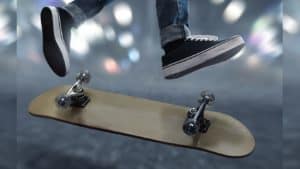
Skateboard History Timeline: Entire History in Brief
- Ed Riley
- December 6, 2023
Since the 1970s, skateboarding has become increasingly popular. But you may be intrigued to know that skateboarding became a popular recreational activity as early as the 1920s.
The documented history of skateboarding dates back to the 1920s and 30s due to mass-produced devices that aided in skating during that period. For example, the Scooter Skate was one of the first notable interesting inventions in the skating world.
Since then, a lot has changed in the skating world. If you want to know more about the evolution of skating, then keep reading.
In the 1920s, something quite similar to a skateboard was introduced in the industry. The three-wheeled metallic device used to practice skating was known as roller skis. The device itself came along with a pole to help it move on the ground.
However, there was no means of steering this makeshift skateboard, unlike the typical skateboard.
One of the earliest forms of skateboarding device was invented in the 1930s. Popularly known as scooter skate, this three-wheeled board combined the components of a skateboard and a scooter.
The scooter skateboard was essentially made of aluminum and steel. It had a handlebar to ensure balance. However, it was very difficult to steer this skateboard due to the large and hard wheels and also the lack of trucks on the skateboard. With all that being said, we may put a finger and say that skateboards originated from scooters.
In the 1940s a device called the Skeeter Skateboard was invented. It had four wheels and aluminum construction. The device even had a removable handle for convenience and axles that allowed it to move easily.
Due to this unique innovation and the introduction of the steering axles, skaters could turn and maneuver easily while skating. This was also the beginning of the installation of trucks in skateboards. Before this, riders could not even steer or maneuver their skateboards.
With the end of the 1950s, commercial toy stores began to stack up on skateboards. In 1959, the first-ever roller-Derby skateboard was introduced to the market. This was one of the few skateboards that were mass-produced initially.
The predominant connection between skating and surfing could be seen very clearly. It can be said that the surfers made their contributions to skateboarding culture and helped to make the sport mainstream among fans and followers. Skateboard culture became the next big thing due to this reason.
In the 1950s, a crude form of skateboarding developed, which is much similar to today’s skateboarding. This was mainly due to the role played by the surfers who took to skating whenever they saw that the surf was low.
The 1960s saw a rise in the trend of skateboarding. In 1962, Val Surf was the first shop to sell skateboards in Hollywood. The best part was that they produced self-made skateboards. These skateboards had trucks and wheels that were taken from roller skates. The board was shaped like a surfboard.
In the very same year, Patterson Boards began making skateboards with better trucks compared to the conventional skateboards that were produced during that time. In the consecutive year, Larry Stevenson from Makaha Skateboards came up with the idea of a kicktail skateboard deck. He is also one of the pioneers in the skating world for coming up with a unique idea for making skateboards.
Throughout the 1960s, several manufacturers made skateboards from plastic that resembled surfing boards. This was the pinnacle era for the sport, as skateboarding gained momentum. There were several skateboarding competitions held worldwide in the same year.
Skateboarding became so popular, that around 50 million skateboards were manufactured worldwide and sold over a short time-specifically three years. The sport had become so popular that the brand Makaha made $4 million in revenue in just two years from 1963-65.
However, this period seemed to be too good to be true for skating enthusiasts. Just like all good things come to an end, the popularity of skateboarding and skateboards also saw a sharp decline in 1966. Sales were punctured as well.
Time changed very quickly as the demand for skateboards fell. This is because instead of focusing on the quality and the workmanship of the skateboard decks, the wheels, the trucks, and even the axles, the companies were just interested in mass production.
It seemed that the skateboard manufacturing companies were only interested in making revenues and not interested in the interests of the skaters. The poor quality of the skateboard decks or the poor quality of the wheels resulted in accidents all over the world. The United States also banned skateboarding as a sport in many of its places due to the rising safety risks.
All of this resulted in the skateboard manufacturers losing out on their share of revenues. Although skateboarding had nearly vanished from the public eyes, a lot of enthusiastic skaters fought hard to keep the sport alive by making their skateboards.
In the 1970s, the skateboard industry made a complete U-turn from a downturn. The board designs started improving gradually. The boards were eventually made from maple plywood, which has the maximum amount of flexibility and strength when it comes to skateboards.
The 70s was often known as the golden age of skateboarding. Hundreds of skateparks were built all over the world. However, this was not to last as the insurance rates grew high and the skateparks had to close down.
But in the end, the skaters who loved the sport kept it alive by skating in their empty pools and backyards. In 1972, Cadillac Wheels by Frank Nasworthy came up with urethane skateboard wheels, which are similar to the wheels used today.
One of the best skateboarding magazines was Thrasher Magazine by Fausto Vitello in 1981. Before the arrival of the Transworld Skateboarding Magazine in 1983, the Thrasher Magazine was the first skateboarding magazine.
At the same time, many other skateboard manufacturers started collaborating with champions like Tony Hawk and even Neil Blender. This revolution in the world of skating opened doors for professional skaters as they could earn up to $10,000 per month. The popularity of skateboarding kept skyrocketing as the Skateboard Associations held contests not only in North America but throughout the world.
Many shoe companies also came up with special shoes for the skating industry. Airwalk, DC, and Simple were the first ever companies that started designing shoes that were meant specially for skating. Even Converse started making skate shoes in collaboration with sports stars such as Rodney Mullen.
By the mid-80s, skateboarding was making another comeback thanks to Powell Peralta, the Bones Brigade Video Show, and other such involvements. Tony Hawk, Mike McGill, Rodney Mullen, and many more pro skaters brought the popularity.
Skateboarding focused more on street-style skating in the 80s. It saw the rise of street style techniques such as ollies and flips. Pro street skaters began to make an appearance as well.
With the evolution of street-style skating, the designs of modern skateboards also evolved.
The recession of 1991 took a big hit on the skateboarding industry. Many companies suffered losses due to the recession. Then in the year 1992, skateboarding’s popularity took another downturn.
There was another reason why the sport became a little infamous during that time. In the early 90s, skateboarder Mark Rogowski killed his former girlfriend. Due to this, there was a stigma on skating activities for a while.
Skateboarding emerged in the scenario again in the mid-90s. Skating scenes were covered in documentaries and television and it was becoming the topic of the town again. The width of the decks also changed during this period.
In the 2000s, skating received widespread popularity among the audience. The X games carried the legacy of skating from the 20th century into the new era.
Moreover, the Skatepark Project had also gained popularity. Over $10 million was given as a grant to above 600 skate park projects in the US. Indoor and outdoor skate parks were built all across the world.
Skateboarding decreased in popularity again at the beginning of 2010. A new competition known as the Street League Skateboarding was introduced. Companies such as Nike and Adidas wanted to jump at the opportunity.
Skating even became an Olympic sport in the 2020 Olympic games.
It is sort of unpredictable what the future holds for skateboarding. This could be another golden age for skateboarding or the popularity could go down. Although the skate parks remain closed due to the onset of the Covid-19 pandemic, skateboard decks are being sold a lot.
Skateboarding is a unique sport with a great heritage and history. Considering its humble beginnings and the ups and downs it has seen, skateboarding is rather doing well now. So, what’s stopping you from grabbing your skateboard deck to skate through the busy streets?
Skate Insider is a participant in the Amazon Services LLC Associates Program, an affiliate advertising program designed to provide a means for sites to earn advertising fees by advertising and linking to Amazon.com
